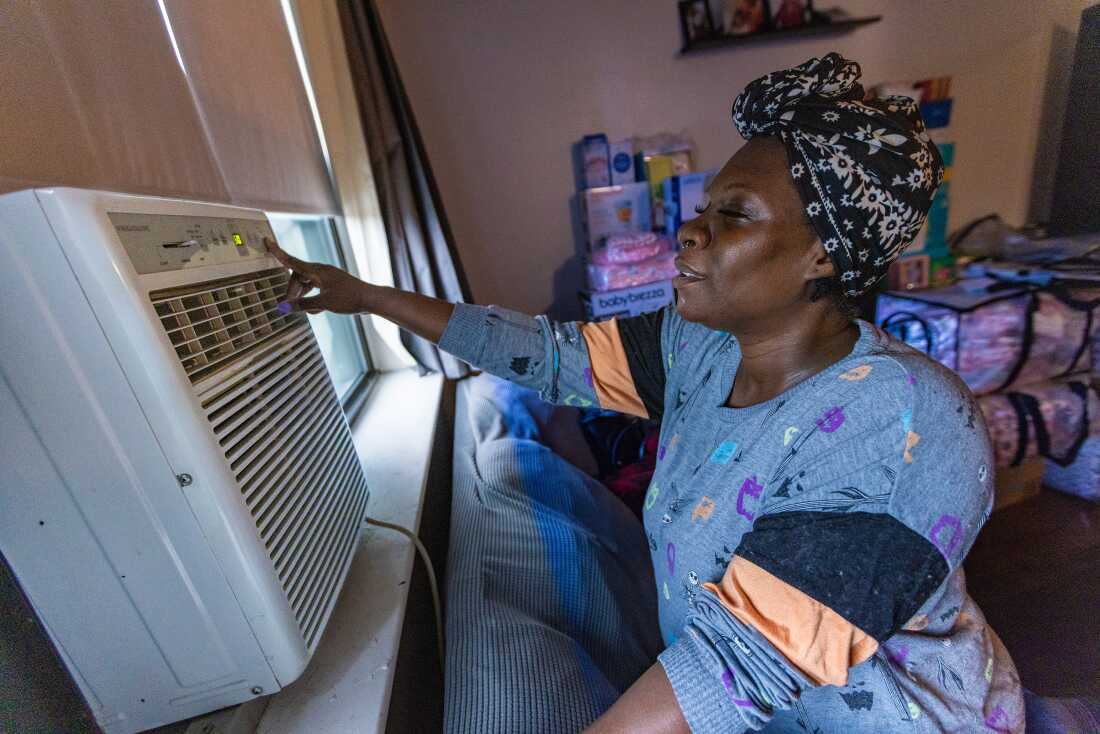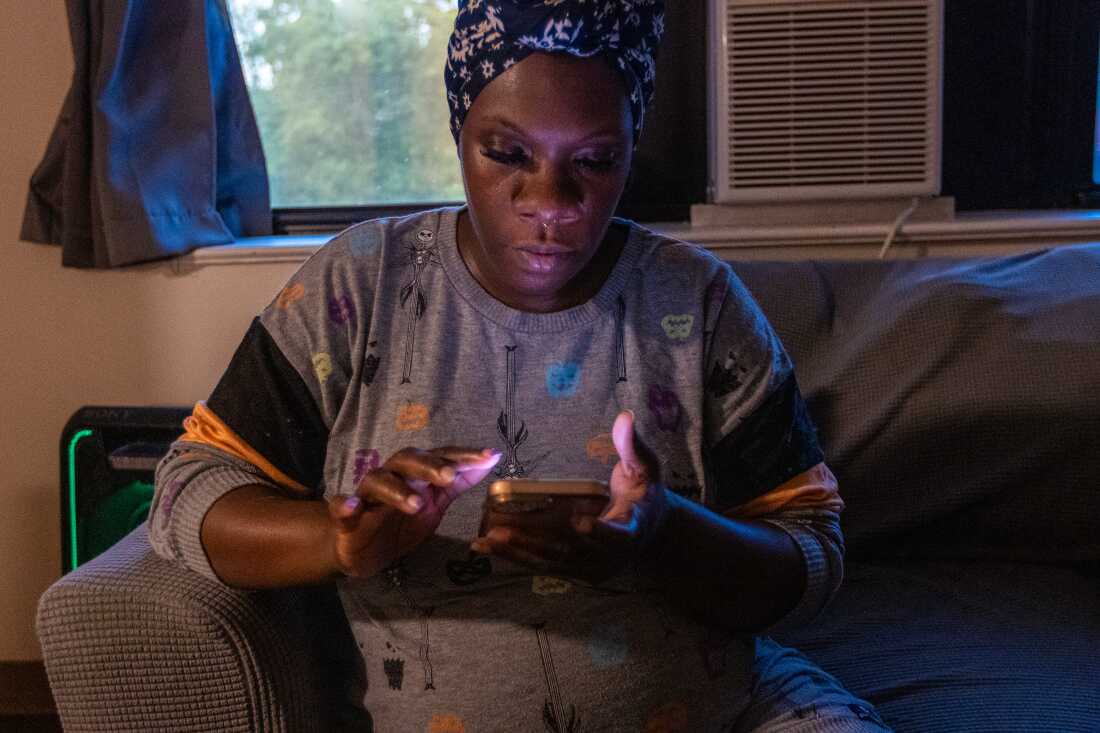
The photo voltaic array on the rooftop of a Boston Medical Middle constructing supplies energy for the constructing in addition to credit for the Clear Energy Prescription program.
Jesse Costa/WBUR
cover caption
toggle caption
Jesse Costa/WBUR
Anna Goldman, a major care doctor at Boston Medical Middle, bought uninterested in listening to that her sufferers could not afford the electrical energy wanted to run respiration help machines, recharge wheelchairs, activate air con or preserve their fridges plugged in. So she labored together with her hospital on an answer.
The result’s a pilot effort known as the Clear Energy Prescription program. The initiative goals to assist roughly 80 sufferers with advanced, continual medical wants preserve the lights on.
This system depends on 519 photo voltaic panels put in on the roof of one of many hospital’s workplace buildings. Half of the vitality generated by the panels helps energy Boston Medical Middle. The remainder goes to sufferers who obtain a month-to-month credit score of about $50 on their utility payments.
Kiki Polk was among the many first recipients. She has a historical past of Sort 2 diabetes and hypertension.
On a heat fall day, Polk, who was 9 months pregnant on the time, leaned into the air con window unit in her front room.

Kiki Polk, one of many first Boston Medical Middle sufferers to enroll within the Clear Energy Prescription program, activates the air conditioner in her dwelling in Boston.
Jesse Costa/WBUR
cover caption
toggle caption
Jesse Costa/WBUR
“Oh my gosh, this feels so good child,” Polk crooned, swaying backwards and forwards. “That is my finest good friend and my worst enemy.”
An enemy, as a result of Polk cannot afford to run the AC. On cooler days, she makes use of a fan or opens a window as an alternative. Polk is aware of the dangers of overheating throughout being pregnant, together with added stress on the pregnant particular person’s coronary heart and potential dangers to the fetus. She additionally has a teenage daughter who makes use of the AC in her bed room — an excessive amount of, in accordance with her mother.
Polk bought behind on her utility invoice. Eversource, her electrical energy supplier, labored together with her on a fee plan. However the payments have been nonetheless excessive for Polk, who works as a faculty bus and lunchroom monitor. She was stunned when employees at Boston Medical Middle, the place she was a affected person, supplied to assist.
“I all the time assume they’re solely there for, you already know, medical stuff,” Polk mentioned, “not the non-public monetary stuff.”
Polk is on maternity depart now to take care of her child, the tiny Briana Moore.

Kiki Polk checks her electrical invoice on her cellphone to see if the credit score from the Clear Energy Prescription has been utilized to her account.
Jesse Costa/WBUR
cover caption
toggle caption
Jesse Costa/WBUR
Goldman, who can be BMC’s medical director of local weather and sustainability, mentioned hospital screening questionnaires present hundreds of sufferers like Polk battle to pay their utility payments.
“I had a dialog lately with somebody who had a hospital mattress at dwelling,” Dr. Goldman mentioned. “They have been utilizing a lot vitality due to the hospital mattress that they have been dealing with a utility shut off. “
Goldman wrote a letter to the utility firm requesting the facility keep on. Final 12 months, she and her colleagues at Boston Medical Middle wrote 1,674 letters to utility corporations asking them to maintain sufferers’ gasoline or electrical energy operating.
Goldman took that quantity to Robert Biggio, the hospital’s chief sustainability and actual property officer. He’d been relying on the photo voltaic panels to assist the hospital shift to renewable vitality, however sharing the facility with sufferers felt prefer it match the well being system’s mission.
“Boston Medical Middle’s been centered on lower-income communities and attempting to alter their well being outcomes for over 100 years,” mentioned Biggio. “So this simply appeared like the appropriate factor to do.”
Standing on the roof amid the photo voltaic panels, Goldman identified a big vegetable backyard one flooring down.
“We’re truly rising meals for our sufferers,” she mentioned. “And equally, now we’re producing electrical energy for our sufferers as a solution to deal with all the elements that may contribute to well being outcomes.”

The rooftop backyard on the Boston Medical Middle administration constructing.
Jesse Costa/WBUR
cover caption
toggle caption
Jesse Costa/WBUR
Many hospitals assist sufferers join electrical energy or heating help as a result of analysis reveals that not having energy or warmth will increase respiratory issues, psychological misery and makes it tougher to sleep. These are frequent issues for low- and moderate-income sufferers, mentioned Aparna Bole, a pediatrician and senior advisor within the Workplace of Local weather Change and Well being Fairness on the Federal Division of Well being and Human Companies.
However Bole mentioned BMC’s strategy to fixing them would be the first of its form.
“To have the ability to join these very sufferers with clear, renewable vitality in such a means that reduces their utility payments is absolutely groundbreaking,” mentioned Bole.
Bole is utilizing a case examine on the photo voltaic credit program to point out different hospitals how they could do one thing comparable.
Boston Medical Middle officers estimate the mission price $1.6 million, and mentioned 60% of the funding got here from the federal Inflation Discount Act. Biggio has already mapped out plans for an extra $11 million in photo voltaic installations on the Boston Medical Middle.
“Our purpose is to scale this pilot and assist much more sufferers,” he mentioned.
The enlargement he envisions would enable a 10-fold enhance in sufferers who might be served by this system, however it nonetheless wouldn’t meet all of the demand.
For now, every affected person within the pilot program receives help for only one 12 months.
Boston Medical Middle is in search of companions who may need to share their photo voltaic vitality with the hospital’s sufferers in alternate for the next federal tax credit score or reimbursement.
Eversource’s vp for vitality effectivity, Tilak Subrahmanian, mentioned the pilot was a posh mission to launch, however now that it is in place, it might be expanded.
“If different establishments are prepared to step up, we’ll determine it out,” mentioned Subrahmanian, “as a result of there may be such a necessity.”
This story comes from NPR’s well being reporting partnership with WBUR and KFF Well being Information.



